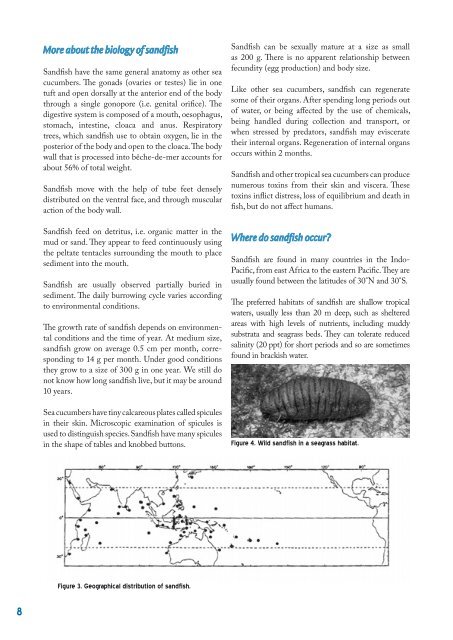Sandfish hatchery techniques - English version - ACIAR
Sandfish hatchery techniques - English version - ACIAR
Sandfish hatchery techniques - English version - ACIAR
You also want an ePaper? Increase the reach of your titles
YUMPU automatically turns print PDFs into web optimized ePapers that Google loves.
More about the biology of sandfish<br />
<strong>Sandfish</strong> have the same general anatomy as other sea<br />
cucumbers. The gonads (ovaries or testes) lie in one<br />
tuft and open dorsally at the anterior end of the body<br />
through a single gonopore (i.e. genital orifice). The<br />
digestive system is composed of a mouth, oesophagus,<br />
stomach, intestine, cloaca and anus. Respiratory<br />
trees, which sandfish use to obtain oxygen, lie in the<br />
posterior of the body and open to the cloaca. The body<br />
wall that is processed into bêche-de-mer accounts for<br />
about 56% of total weight.<br />
<strong>Sandfish</strong> move with the help of tube feet densely<br />
distributed on the ventral face, and through muscular<br />
action of the body wall.<br />
<strong>Sandfish</strong> feed on detritus, i.e. organic matter in the<br />
mud or sand. They appear to feed continuously using<br />
the peltate tentacles surrounding the mouth to place<br />
sediment into the mouth.<br />
<strong>Sandfish</strong> are usually observed partially buried in<br />
sediment. The daily burrowing cycle varies according<br />
to environmental conditions.<br />
The growth rate of sandfish depends on environmental<br />
conditions and the time of year. At medium size,<br />
sandfish grow on average 0.5 cm per month, corresponding<br />
to 14 g per month. Under good conditions<br />
they grow to a size of 300 g in one year. We still do<br />
not know how long sandfish live, but it may be around<br />
10 years.<br />
Sea cucumbers have tiny calcareous plates called spicules<br />
in their skin. Microscopic examination of spicules is<br />
used to distinguish species. <strong>Sandfish</strong> have many spicules<br />
in the shape of tables and knobbed buttons.<br />
Figure 3. Geographical distribution of sandfish.<br />
<strong>Sandfish</strong> can be sexually mature at a size as small<br />
as 200 g. There is no apparent relationship between<br />
fecundity (egg production) and body size.<br />
Like other sea cucumbers, sandfish can regenerate<br />
some of their organs. After spending long periods out<br />
of water, or being affected by the use of chemicals,<br />
being handled during collection and transport, or<br />
when stressed by predators, sandfish may eviscerate<br />
their internal organs. Regeneration of internal organs<br />
occurs within 2 months.<br />
<strong>Sandfish</strong> and other tropical sea cucumbers can produce<br />
numerous toxins from their skin and viscera. These<br />
toxins inflict distress, loss of equilibrium and death in<br />
fish, but do not affect humans.<br />
Where do sandfish occur?<br />
<strong>Sandfish</strong> are found in many countries in the Indo-<br />
Pacific, from east Africa to the eastern Pacific. They are<br />
usually found between the latitudes of 30°N and 30°S.<br />
The preferred habitats of sandfish are shallow tropical<br />
waters, usually less than 20 m deep, such as sheltered<br />
areas with high levels of nutrients, including muddy<br />
substrata and seagrass beds. They can tolerate reduced<br />
salinity (20 ppt) for short periods and so are sometimes<br />
found in brackish water.<br />
Figure 4. Wild sandfish in a seagrass habitat.
















